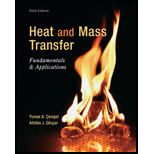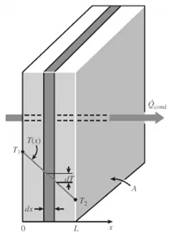
Consider heat conduction through a wall of thickness L and area A. Under what conditions will the temperature distributions in the wall be a straight line?
The condition under which the temperature distribution in the wall is a straight line.
Explanation of Solution
The temperature distribution of a wall with thickness L and area A is shown in the figure below:

The one-dimensional steady state heat conduction equation without heat generation for the wall is
Here, T is the temperature and x is the direction of flow of heat.
Integrate equation (1) with respect to x.
Where, c1 is the constant of integration.
Further integrate the equation (2) with respect to x.
Now, calculate the constant of integration.
At x = 0, T =T1
Substitute the value in equation (3);
Substitute the value of c2 in equation (3);
Substitute the value of c1 and c2 in equation (3);
The above equation is in the form of a straight line equation y = mx+c. Thus, the distribution of temperature in the plane wall will be a straight line during steady-state one dimensional heat transfer.
Thus, the following are the conditions during which the temperature distribution in the wall is a straight line.
- Heat conduction in one-dimensional steady state direction.
- Thermal conductivity should be constant.
- There is no any internal heat generation in the wall.
Want to see more full solutions like this?
Chapter 3 Solutions
Heat and Mass Transfer: Fundamentals and Applications
- 3.16 A large, 2.54-cm.-thick copper plate is placed between two air streams. The heat transfer coefficient on one side is and on the other side is . If the temperature of both streams is suddenly changed from 38°C to 93°C, determine how long it takes for the copper plate to reach a temperature of 82°C.arrow_forward2.9 In a large chemical factory, hot gases at 2273 K are cooled by a liquid at 373 K with gas-side and liquid-side convection heat transfer coefficients of 50 and , respectively. The wall that separates the gas and liquid streams is composed of a 2-cm thick oxide layer on the gas side and a 4-cm thick slab of stainless steel on the liquid side. There is a contact resistance between the oxide layer and the steel of . Determine the rate of heat loss from hot gases through the composite wall to the liquid.arrow_forwardA wall with a brick and concrete layer is shown in the figure. The wall has a length of 15 m and 6 m high. The brick (k = 1.3 W/m-K) has a thickness of 75 mm and the concrete (k = 2 W/m-K) is 150 mm thick. Determine the total heat resistance, the heat transfer rate through the wall, and the temperature of its inner surface for a day during which the room is maintained at 20°C while the temperature of the outdoors is 32°C. Take the convection heat transfer coefficients on the inner and outer surfaces of the wall to be 12 W/m2-K and 18 W/m2-K, respectively, which includes the effects of radiation. Round off your final answer to three (3) decimal places.arrow_forward
- A cylindrical body having 10 cm diameter and lenth of 30 cm passes through a heat treatment furnace which is 6 m in length. The body must reach a temperature of 800°C before it comes out of the furnace. The furnace gas is at 1250°C and body initial temperature is 90°C. How much time it will take to attain the required temperature ? Take h = 100 W/m² °C. Take K(steel) = 40 W/m°C and a (thermal diffusivity of steel) = 1.16 x 10-5 m²/s.arrow_forwardConsider heat transfer through a windowless wall of a house on a winter day. Discuss the parameters that affect the rate of heat conduction through the wall.arrow_forwardA cast iron pipe (k = 80 W/m - oC) whose inner and outer diameters are 5 cm and 5.5 cm respectively is coverd with a 3 cm thick glass wool insulation (k = 0.05 W/m - oC) The temperature at the inner surface of the pipe is 320 oC and the interface temperature between the pipe and insulation is 300 oC. Determine the surface temperature of the insulation.arrow_forward
- On a multi-layered square wall, the thermal resistance of the first layer is 0.005 ° C / W, the resistance of the second layer is 0.2 ° C / W, and the third layer is 0.1 ° C / W. The overall temperature gradient in the wall is multilayered from one side. to the other side is 70 ° C. a. Determine the heat flux through the walls. = Answerwatts / m2. b. If the thermal resistance of the second layer is changed to 0.4 ° C / W, what is the effect in% on heat flux, assuming the temperature gradient remains the same? = AnswerAnswer%.arrow_forwardA 12 cm outside diameter and 10-cm inside diameter cast iron pipe with conductivity of 80 w/m-K has 4cm of polystyrene insulation with a conductivity of 0.027 w/m-k. saturated steam at 5000 C is flowing through the pipe and the outside surface temperature is 60 C. determine the heat transfer per 150 meter of pipe.arrow_forwardA steel plate having a thickness of 100 mm is suddenly exposed to a hot gas at 1000 oC in a furnace. One surface of the plate is heated while the other surface of the plate can be approximated to be adiabatic. The initial temperature of the steel plate is 20 oC. The thermal conductivity and thermal diffusivity of the steel plate are 34.8 W/m K and 0.555 x 10-5 m2 /s respectively. The convective heat-transfer coefficient is 174 W/m2 K. a) Determine the time necessary to raise the surface temperature of the steel plate to 500 oC. b) Determine the maximum temperature difference in the cross-section of the steel plate at the time evaluated in part a) above. c) Determine the heat energy transferred to the steel plate per unit wall surface area by the time evaluated in part a) above. Use the conduction chartsarrow_forward
- Consider a large 5-cm-thick brass plate (k = 111 W/m·°C) in which heat is generated uniformly at a rate of 2×105 W/m3. One side of the plate is insulated while the other side is exposed to an environment at 25 °C with a heat transfer coefficient of 44 W/m2·°C. (Hint: The heat transfer surfaces of the large plane walls considered in our lecture have the same temperature. The formula is slightly adjusted for this question.) Where is the maximum temperature located? What is the value of the maximum temperature in °C?arrow_forwardA steam pipe of 120-mm outside diameter is covered with a 20-mm-thick layer of calciumsilicate insulation (k = 0.089 W/m-K). The pipe surface temperature is 800 K, and theambient air and surroundings temperatures are 300 K. The convection and radiationcoefficients for the outer surface of the insulation are estimated as 5.5 W/m2-K and 10W/m2-K, respectively. Determine the heat rate per unit length from the pipe (W/m) andthe insulation outer surface temperature.arrow_forwardhow is a three-dimensional heat equation reduced if heat transfer occurs in an insulated long, thin rod or wire of a specific length? Explain what will be the new equation?arrow_forward
 Principles of Heat Transfer (Activate Learning wi...Mechanical EngineeringISBN:9781305387102Author:Kreith, Frank; Manglik, Raj M.Publisher:Cengage Learning
Principles of Heat Transfer (Activate Learning wi...Mechanical EngineeringISBN:9781305387102Author:Kreith, Frank; Manglik, Raj M.Publisher:Cengage Learning
